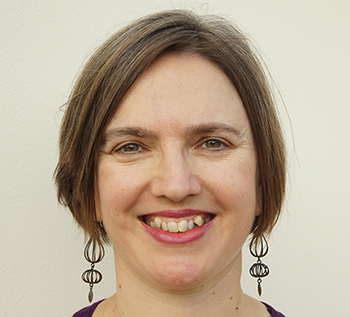
Anna Holian
Arizona State University Professor Anna Holian visited USC on October 10 to give a lecture at the USC Max Kade Institute for Austrian-German-Swiss Studies. While she was here, she spent two days at USC Shoah Foundation Center for Advanced Genocide Research watching testimony for her new project on Jewish merchants in Munich and Frankfurt after World War II.
Holian’s research at Arizona State generally focuses on the early post-World War II period in Europe. She has already worked on projects about Jewish life in Germany after the Holocaust, but became more interested in researching how Jews survived economically after living through the Holocaust.
Holian has begun by researching shopkeepers in Frankfurt and Munich after around 1948. Trade and commerce have always been cornerstones of Jewish livelihoods in Germany and in fact was one of the only way Jews could make a living after the war. It was also a main point of contact between Jews and Gentiles, which was difficult for some Holocaust survivors in light of what they had just been through.
“I was interested to think about what does that look like after the Holocaust and in a place like Germany, the epicenter of the Holocaust, how do you make a home for yourself among Germans and how do you do business with Germans?” Holian said. “This was an open point of controversy among Jews in the early post war period. Is it possible to live among the murderers and do business with them, trade with them?”
In the Visual History Archive, Holian searched for nearly 190 names of survivors known to have operated shops in a specific marketplace in Munich after the war and found a large number of their testimonies. During her two days at USC Shoah Foundation, she began watching the testimonies of the survivors she is already familiar with – which gave her a new perspective on people she had previously learned about only through historical records.
“That in itself was really great to actually be able to see these people and hear them,” she said.
One man, Jakob Szackamer, operated his business in the marketplace longer than almost any other shop, until the mid-1950s. Holian found it interesting that he gave his testimony in Yiddish despite having lived and done business in Germany for years. Clearly, he never completely assimilated into German culture.
In another testimony, a survivor described deciding to leave Germany even after establishing a successful business because he decided he just couldn’t live there anymore. Holian noted that for many Jewish shopkeepers and tradespeople, doing business in Germany was simply a means for them to save enough money to ultimately leave.
“Why people stayed and why people left and how their economic lives factored into their calculations about their lives more generally is really interesting to me,” she said. “I’m using shops and shopkeepers as a window onto these broader questions on economic life.”
Today, it can be difficult for Jews to discuss openly how their community established itself in the tumultuous years just after the war and became as successful as it is today. But Holian believes it is important to delve deeper into the origins of the current-day German Jewish community, and its economics are an illuminating place to start.
“Trade was an absolutely central economic foundation to post war Jewish existence in Germany,” Holian said. “This is really a fundamental part of what it looks like today – the fact that people were eventually able to establish themselves, send their children to school, allow their children to pursue careers – so I think it’s absolutely essential to the foundation of that community.”